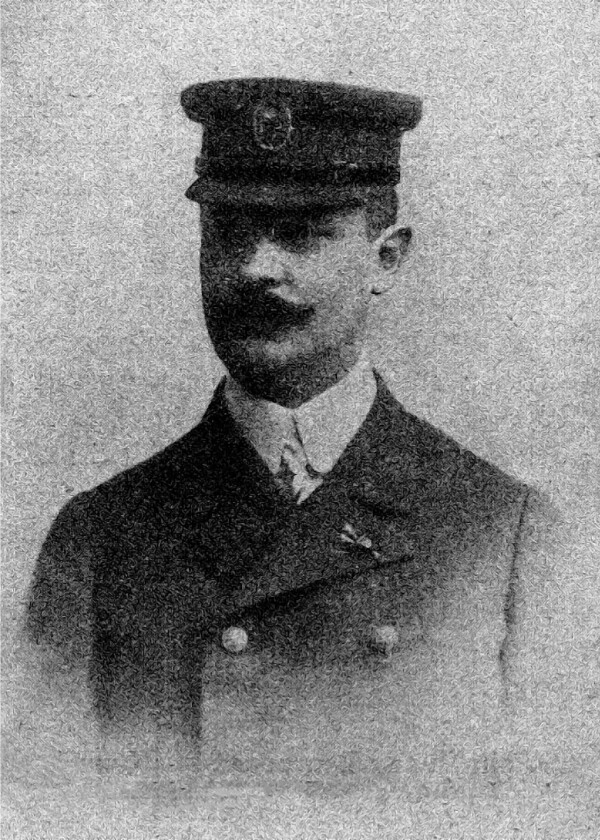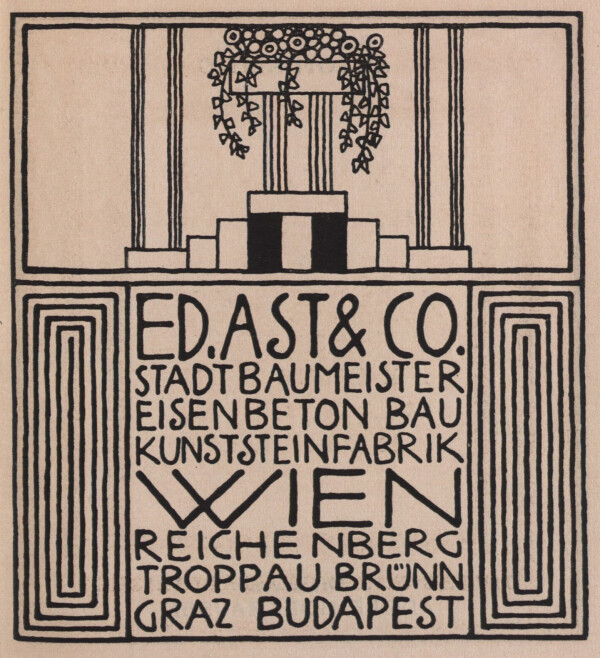Eduard Ast

Eduard Ast, in: Allgemeine Sport-Zeitung, 05.01.1919.
© Klimt Foundation, Vienna

Advertisement of the company Ed. Ast & Co., in: N. N.: Katalog der Kunstschau Wien 1908, Ausst.-Kat., Exhibition building Lothringerstraße (Vienna), 01.06.1908–15.11.1908, Vienna 1908.
© Library of the Belvedere, Vienna
The Viennese building contractor and engineer Eduard Ast was an important patron and supporter of the so-called “Klimt Group.” He owned a villa in the “Künstlerkolonie,” the artists’ colony built by Josef Hoffmann on Hohe Warte, and bought several paintings by Gustav Klimt.
Eduard Ast was born in Vienna in 1868. Around the turn of the century, the experienced building contractor took over the renowned concrete construction company and cement products factory of Julius Chailly and initially continued its operations under the name “Ingenieur Eduard Ast” at Porzellangasse 25 in the 9th District of Vienna. The technically innovative company soon operated under the name “Eduard Ast & Co.” – with Eduard Ast himself named as a partner from now on. In the following years, the successful company repeatedly advertised in prestigious newspapers and magazines – including Ver Sacrum, the magazine of the Vienna Secession.
Collaboration with the Klimt Group
It is impossible to verify today exactly how the ties between Eduard Ast and artists such as Gustav Klimt and Josef Hoffmann were initially formed. A successful collaboration of the Klimt Group, whose members left the Vienna Secession in 1905, and the company Eduard Ast & Co. is well documented for the “Kunstschau Wien 1908” and the “Internationale Kunstschau Wien 1909,” initiated by Klimt and other artists. The catalogues of both “Kunstschau” exhibitions repeatedly mentioned that any construction work and concrete structures had been executed by the company Eduard Ast & Co. In this context, the Neue Freie Presse reported about the following personal gesture on 22 April 1909:
“Shortly after the opening, the artists of the ‚Kunstschau‘ privately honored the engineer Eduard Ast by presenting him with a very nicely designed album of works by Klimt and other artists in recognition of his achievements in building the ‚Kunstschau‘ facilities.”
At the “Kunstschau Wien 1908”, Gustav Klimt also exhibited the two paintings Friends I (The Sisters) (1907, Klimt Foundation, Vienna) and Danaë (1907/08, privately owned), which Eduard Ast presumably purchased immediately before or after the exhibition. Ast later also came into possession of the painting Pallas Athene (1898, Wien Museum, Vienna), whose original owner had been the industrialist Viktor Zuckerkandl.
Villa Ast on Hohe Warte
In 1909, Eduard Ast commissioned Josef Hoffmann to build a multi-storey villa with a large garden in the “Künstlerkolonie” on Hohe Warte in the 19th District of Vienna. A detailed report by Amelia Sarah Levetus with many photographs published in the magazine Moderne Bauformen documents the exact positions in which the two Klimt paintings were hung in the villa. Eduard Ast and his family lived in the house until 1913. Afterwards, it was for several years inhabited by Alma Mahler-Werfel, the stepdaughter of the painter Carl Moll, and her husband Franz Werfel.
Further Developments
Eduard Ast held many lectures on the technical aspects of construction and, together with Josef Hoffmann, played an important role in the founding of the Austrian Werkbund, in which he served as a panel member. Ast was a passionate oarsman and president of the Viennese rowing club Ruderverein Donauhort for many years from 1907. His company Eduard Ast & Co. was forced to file for bankruptcy in 1932. The popular contractor died in Vienna in August 1945.
Literature and sources
- Amelia Sarah Levetus: Die Villa Ast in Wien von Professor Josef Hoffmann, in: Moderne Bauformen. Monatshefte für Architektur und Raumkunst, 12. Jg. (1913), S. 1-24.
- Neue Freie Presse, 22.04.1909, S. 1.
- Der Bautechniker. Centralorgan für das österreichische Bauwesen, 18. Jg., Nummer 3 (1898), S. 44.
- Neues Wiener Tagblatt, 01.05.1913, S. 12.
- Kleine Volks-Zeitung, 01.02.1936, S. 4.
- Vereinigung bildender Künstler Österreichs Secession (Hg.): Ver Sacrum. Organ der Vereinigung bildender Künstler Österreichs, 1. Jg., Heft 8 (1898), S. 1.
- Felix Czeike (Hg.): Historisches Lexikon Wien, Band 1, Vienna 1992, S. 177.
- Felix Czeike (Hg.): Historisches Lexikon Wien, Band 3, Vienna 1994, S. 85.
- Max Eisler: Österreichische Werkkultur, Vienna 1916, S. 241.
- N. N.: Die Eröffnung der "Kunstschau", in: Die Zeit, 22.04.1909, S. 3.
- N. N.: Rudern. Baurat Ast als Jubilar, in: Sport-Tagblatt, 16.11.1933, S. 7.

